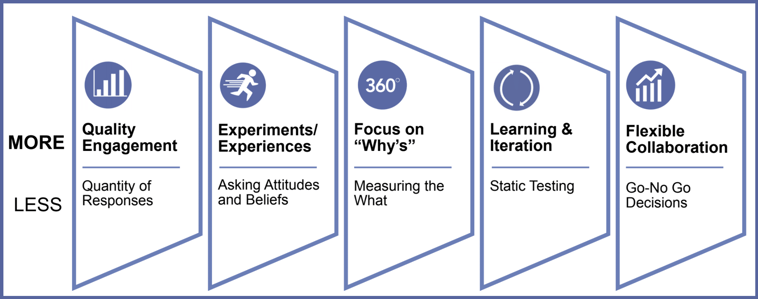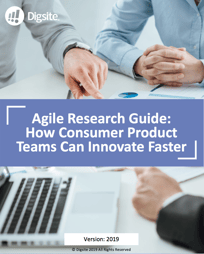Thanks to new research approaches, all companies—even those with storied histories—can innovate as quickly as startups, leveraging consumer insights to inform the best way forward.
In fact, here at Digsite, we are seeing more and more companies moving away from requesting help with ‘research projects’ and moving toward a more agile approach to where rapid research is embedded into the development process.
In this post, you will learn:
- Why agile approaches to solving "wicked problems" are relevant to CPG companies today
- How Tillamook, a U.S.-based dairy and cheese company, recently doubled its market share using agile research during product development
- What happens when companies like Tillamook, Organic Valley and others take an agile approach to market research and simultaneously build, test and learn
Case in Point - Tillamook
For over 100 years, Tillamook has been delighting customers with cheese and dairy products. The company has enjoyed success over the last century—even though that success was achieved with limited access to consumer insights.
Recently, Tillamook—which had a 0.6% share of the $5.3 billion shredded cheese category—was seeking to drive faster growth and earn an even bigger share of that market.
By adopting a new approach to consumer research, the cheesemaker was able to create more compelling products for its customers. The results have been astounding. With new, more agile, tools and processes in place, Tillamook has been able to drive 26% growth over the last five years.
Staring Down ‘Wicked Problems’
Companies today face “wicked problems.” These challenges are multi-faceted and socially complex. In many instances, it’s hard to see exactly what the optimal solution might look like, and it’s even more difficult to guess what outcomes that solution might bring with it. Wicked problems involve changing consumer behavior and are driven by interdependent and multi-causal factors.
In his book, Agile Product Development: How to Design Innovative Products That Create Customer Value, Tathagat Varma suggests that in order to solve wicked problems, a paradigm shift is required: “The problem is fully understood only after it is solved. This means that intermediate results must be obtained before a final solution can be reached or that a problem is defined and solved at the same time.”
Solving these problems through traditional methods might be possible. What’s virtually impossible, however, is solving them quickly and efficiently using dated approaches.
This is precisely where agile research enters the equation.
How Agile Helps Solve ‘Wicked Problems’
As consumer brands strive to solve complex problems more quickly, marketing and innovation teams are looking for better ways to discover actionable insights and improve product outcomes.
By implementing an agile research process, consumer driven companies can utilize small, iterative research sprints in a test-and-learn cycle. This enables them to discover the insights they need to inform new product development, marketing campaigns, packaging designs, and more. Instead of conducting a single study and acting on those results, agile research allows teams to repeatedly engage with research participants over days or weeks. This helps researchers drill beyond the what to understand the why, and to iterate as they learn.
Here’s how it works: Researchers identify the problem and initial solution ideas, test among their target audience, and learn from these efforts. Based on that knowledge, they can re-engage participants or repeat the process again.
For example, Organic Valley recently used agile research to find out about potential new packaging designs. They quickly found out that their assumptions were incorrect; customers preferred the existing packaging to potential new designs. Based on this information, Organic Valley was able to revise its concepts, ask additional follow-up questions in the same research study, and ultimately end up with packaging that excited its customers.
Agile research enables you to break big problems down into small sprints that might last anywhere between a single day and two weeks. As the Organic Valley example illustrates, agile focuses on iterative learning—discover something new, asking questions based on that information, and continuing the process until you’re confident you’ve solved the problem.
Team collaboration is a critical component of any successful agile research sprint. Remember, wicked problems are complex. Having a cross-functional group on your sprint team will help you diverge and converge on ideas as you learn—and help you arrive at a better solution faster.
By collecting context-driven consumer feedback—and continuing to test and iterate over time—agile researchers can know with certainty that they are rolling out the best solutions.
Case Study: Tillamook
Tillamook’s wicked problem was figuring out how to unlock growth in a crowded category.
The company wanted to learn how to get more customers interested in one of its shredded cheese products. Tillamook summed up its challenge thusly: “elevating a bag of sticky goo.”
After doing its due diligence, Tillamook ultimately decided to use Digsite to understand consumer reactions to their shredded cheese product in order to optimize their offerings.
In response to the research findings from their Digsite Sprint, Tillamook changed their packaging to reflect consumer needs. They also changed from finer cheese shreds to thick cut shreds. They even adjusted their marketing communication to play back the experience consumers had using the product.
The results speak for themselves. Tillamook saw an 86% increase in sales of its shredded cheese product. Distribution went up 47% and Tillamook doubled its market share from 0.6% to 1.2%.
Suffice it to say that building agile research capabilities went a long way for the cheesemaker.
Getting Started with Agile
By now, you understand the promise of agile. But you can’t just snap your fingers and expect to change your organization’s approach to research approach overnight. So, how do you get started?
First things first: raise the profile of online qualitative research at your organization. Once you’ve gotten the support needed to kick things off, you need to deliver quick wins—something tangible—on strategically important initiatives. That way, you will have something to reference as you try to get agile adopted on a broader scale.
Always think ahead, too. You don’t want to spend a lot of time designing a research initiative that only helps one or two projects. Your initiatives need to be repeatable so that they can pay off beyond the initial ask—helping everyone across the organization.
Remember, smart and scrappy wins the day. Follow a plan until your learning convinces you to move in a new direction. Don’t be afraid to slaughter sacred cows, either. Just because things have been done one way forever doesn’t mean that is the best way forward.
As you get started, keep these agile principles in mind:
- Quality of engagement over quantity of responses
- Experiments and experiences over asking attitudes and beliefs
- Focus on the why instead of measuring the what
- Learning and iteration over static testing
- Flexible collaboration over go/no-go decisions

You Can Do It Too—Transform Your Organization with Agile Research
Like Tillamook’s case study illustrates, agile has the power to transform your organization. Even if you are operating in a highly saturated market—and you’ve been around for 100-plus years—you can still use agile research to supercharge your brand and delight your customers.
There’s no sense in basing decisions on gut instinct when you don’t have to. Thanks to agile research, you can drill deeper and find out what your customers are actually thinking. Instead of asking them whether they like something or not, you can find out why they like something or don’t like it. For the best results, keep asking follow-up questions until your confident with your conclusions.
The path to agile research might be a bit bumpy when you’re just starting out. But that’s true of anything else, too. Devise a plan, mobilize your team, and follow through. Let agile research inform the development of your products, campaigns, websites, packaging and more. That’s the ticket to bringing products to market with confidence.
Ready to learn more or get started? Download our free ebook, Agile Research Guide: How Consumer Product Teams Can Innovate Faster.





